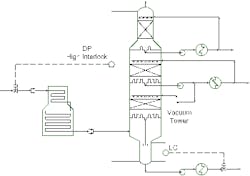The design basis for many pressure-vessel foundations includes sufficient capability to handle the load of the vessel full of water. Designing to such a load enables hydrotesting the vessel full of water in one step after modifications. No rule forces a plant to build a foundation to meet the full-of-water load requirement. However, foundations for most storage vessels comply. It's normally expected that liquid will fill these tanks at some point. Even if the design liquid is less dense than water, typical practice is to assume the vessel may be filled with water.
[pullquote]
Some foundations can't tolerate the load of a vessel completely full of water, though. Most commonly, these less substantial foundations are used with large distillation towers. Such towers rarely are completely full during operation. However, upset conditions that create high liquid level may allow the load in a vessel to exceed foundation limits.
Additionally, two other situations can create questions about acceptable foundation loads. Many older foundations included wood pilings. Monitoring may have shown damage to the pilings that limits allowable weight on them. In addition, foundation design criteria have changed over time. What may have been suitable in the past no longer may be judged sufficient. Standard practice is that an existing foundation that met requirements when built need not be changed even if it doesn't satisfy current ones — so long as the structure's load doesn't increase by more than a small amount. Despite this, a plant might choose to impose on critical equipment operating limits that reflect the more stringent requirements.
ANDREW SLOLEY is a Contributing Editor to Chemical Processing. You can e-mail him at [email protected]



